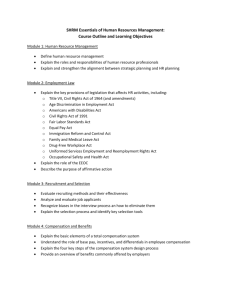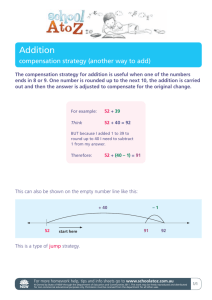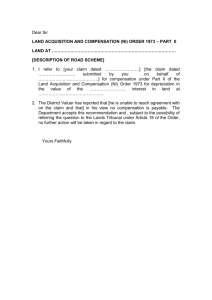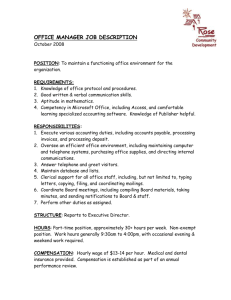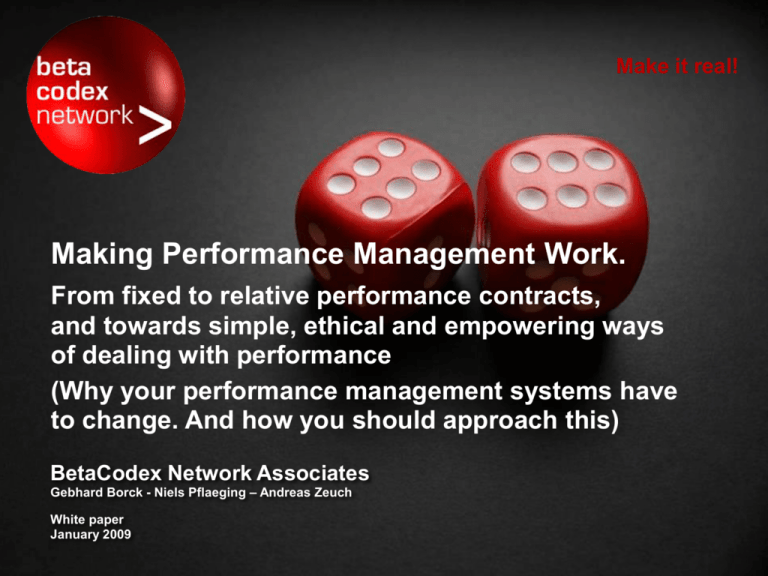
Make it real!
Making Performance Management Work.
From fixed to relative performance contracts,
and towards simple, ethical and empowering ways
of dealing with performance
(Why your performance management systems have
to change. And how you should approach this)
BetaCodex Network Associates
Gebhard Borck - Niels Pflaeging – Andreas Zeuch
White paper
January 2009
Traditional management processes keep teams from
strategic thinking, and motivate counterproductive or
unethical behavior
Financial problems
• Process takes too long
• Plans become obsolete
quickly
• Plans are of little or no use
Vision
Targets and
strategic guidelines
Strategic problems
Profitability in petrochemical industry in Europe
600
Fixed
performance
contacts and
“keep on track”
•
•
•
•
•
•
500
Target negotiation
Definition of incentives
Activity planning
Resource allocation
Coordination of plans
Approval
400
300
200
100
0
1984 1986 1988 1990 1992 1994 1996 1998 2000
Source: Chem Systems
Behavioral problems
Budget
Performance control
(plan-actual)
Bonus (vs. targets)
...
Source: BBRT
White paper – Making Performance Management
2
© BBTN – All rights reserved
Management processes in command and control
organizations are “straight jackets”
Strategy
Strategic
learning cycle
Annual
Fixedplan
Performance
Contract
Budget
Management
control cycle
“Fixed” performance
contract
• Period
[Fixed]
• Targets
[Fixed]
• Compensation
[Fixed]
• Plan
[Fixed]
• Resources
[Fixed]
• Coordination
[Fixed]
• Control
[Fixed]
• Agreed through
[Negotiation]
• Signed by: [Manager/Director]
Control
Tayloristic management works like this: As centralistic-burocratic
hierarchies,
together
through a regime33 of fixed performance contracts!
Source:
BBRT
White
paper
–held
Making Performance
Management
© BBTN – All rights reserved
Current practices are misaligned with the
Critical Success Factors of today's competitive market
places
Six “Critical Success Factors”
Six examples of misalignment
• Fast response
Annual planning process retards it
• Innovation
Centralized bureaucracy stifles it
• Operational excellence
‘Spend it or lose it’ mentality fights it
• Customer intimacy
Short term targets prevent it
• Best team
Extrinsic ‘motivators’ undermine it
• Ethical behaviour
Dysfunctional, even unethical behaviour
conflicts with it
• Value creation
• Inferior financial results
When pressure is
applied,
misalignment gets
White paper – Making Performance Management
worse!
4
© BBTN – All rights reserved
Can you read the future, from the bottom
of a cup of coffee? Or do you have a
crystal ball that lets you to look into the
future? Can you read the cards and see
what will happen next year? Well, if none
of this actually works, and if we accept
that it´s impossible to predict the future,
then why do we still spend massive energy
and time on formal techniques that try to
achieve just that for businesses?
White paper – Making Performance Management
5
© BBTN – All rights reserved
Organizations need a different, trust-based form of
“future-directed thinking”, not command and control!
The secret of success is not to foresee the future.
But to build an organization that is able to prosper
in any of the unforeseeable futures.
Michael Hammer
White paper – Making Performance Management
6
© BBTN – All rights reserved
Applying the BetaCodex means:
From fixed to adaptive management processes.
Traditional model
(fixed performance contracts,
negotiated in advance)
New model
(relative performance contracts,
assessed with hindsight)
Relative
performance
contracts
strategy
Fixed
performanc
e
contracts
Changing
processes
Dynamic
coordination
control
• Fixed, annual processes
• Fixed targets and incentives
• Centralized and
bureaucratic control
White paper – Making Performance Management
7
• Dynamic, continuous
processes
• Relative
targets/compensation
• Self-control, transparency
and peer pressure
© BBTN – All rights reserved
But there is a further challenge. Which is why most theories
about leadership, as well as most advice from consultants,
are flawed...
One cannot talk sensibly about leadership, or people
management, nor design decent management
processes, unless we clarify beforehand our beliefs with
regards to what
people in organizations are like.
We have to arrive at a shared understanding of
human nature and of the consequences of that for our
organizations.
Niels Pflaeging, Leading with Flexible
Targets
White paper – Making Performance Management
8
© BBTN – All rights reserved
Theory X
vs.
Theory Y
Douglas McGregor
White paper – Making Performance Management
99
© BBTN – All rights reserved
The industrial age management model not only fails
because markets have changed. It is also misaligned with
human nature.
Theory X (0%)
People dislike work, find it boring,
and will avoid it if they can.
People must be forced or bribed
to make the right effort.
Theory Y (100%)
Attitude
People need to work and want to take an
inte-rest in it. Under right conditions, they
can enjoy it.
Direction
People will direct themselves towards
a target that they accept.
Responsibility
People would rather be directed than
People will seek and accept
accept responsibility, which they avoid.
responsibility, under the right conditions.
Motivation
People are motivated mainly by
Under the right conditions, people are
money
moti-vated by the desire to realize their own
and fears about their job security.
potential.
Creativity
Most people have little creativity Creativity and ingenuity are widely
except when it comes to getting round
distributed
rules.
and grossly underused.
Based on Douglas McGregor, ‘The Human Side of Enterprise’, 1960
White paper – Making Performance Management
10
© BBTN – All rights reserved
Question:
How often do the systems,
especially the HR systems,
get in the way of change, transformation,
vision and strategic thinking?
Answer:
Far too often.
History often leaves HR people in highly bureaucratic
personnel functions that discourage leadership and
make altering human resource practices a big
challenge.
upon
John Kotter,
Leading Change, p, 110-111
WhiteSource:
paper –based
Making
Performance
Management
11
© BBTN – All rights reserved
Do you BELIEVE in Theory Y?
Firmly?
Good. Because we are sure then you would
never, ever practice (or support, or tolerate) HR
processes and tools that treat people like
children, or animals, or worse. Right? Such as
performance appraisals, individual target setting,
incentive compensation, meritocracy, or control of
work-hours…
White paper – Making Performance Management
© BBTN – All rights reserved
12
Do your HR systems make it in people's best interest to
implement your new vision?
What is meant by HR systems?
Performance appraisal
Compensation
Hiring and Promotions
Succession planning
...
Most often, examination of a firm's human resource systems reveal:
Performance evaluation processes have virtually nothing to do with
customers or strategy – yet that is typically at the core of a new vision or
management model
Compensation decisions are based much more on not making
mistakes than on creating the right and useful change
Promotion decisions are made in a highly subjective way and seem to
have at best a limited relationship to the change effort
Recruiting and hiring systems are a decade old and only marginally
support the transformation
Source: J. Kotter, Leading Change, HBSP, p, 110-111
White paper – Making Performance Management
13
© BBTN – All rights reserved
Let's start with compensation then.
First of all, let's be clear. Carrots don't work.
They might beat the intellect of donkeys. But they certainly
don't trick human beings, who all have “Theory Y”
wiring inside them. Incentives simply don't
have a positive influence on organizational
performance. Full stop.
So why do so many of us still apply
in the carrot-and-stick method with people?
White paper – Making Performance Management
14
© BBTN – All rights reserved
Background stories we wouldn´t tell our clients:
Real-life examples from companies
The case of Marie Taylor
This is what happened:
Marie Taylor, a sales person from our organization, has
generated income that goes against our company´s principle
“Always act to the benefit of our customers“.
The decision: Marie Taylor is being transferred to the internal
sales support department. All her bonuses rights have been
immediately cancelled.
The background story:
It is true – all sales people are obligued to act in the interest of
customers.
But it is also true that 40% of Marie Taylor´s salary depend on the
amount of net sales she generates.
White paper – Making Performance Management
15
© BBTN – All rights reserved
Background stories we wouldn´t tell our clients:
Real-life examples from companies
The case of Frank Miller
This is what happened:
Frank Miller, a consultant, has overcharged during his
work with clients, which means he has systematically
inflated the amount of worked hours charged to his
customers.
The decision: Frank Miller was fired and is leaving the
company immediately.
The background story:
It is true: Frank Miller has acted against the law, by charging for more
than
he has actually worked for his clients.
But it is also true that 25% of Frank Miller´s income depend on the
hours charged to clients…
White paper – Making Performance Management
16
© BBTN – All rights reserved
An example: “motivation”, or “threat”?
What compensation systems really do...
System with no
variable compensation
System with variable compensation
(bonus, incentive, etc.)
30%
Variable
compensation
100%
Base salary
100%: Total
compensation
expected by
employee.
Is this an
“energizing
promise”, or is it
just a pitiful threat?
“We have an aggressive pay
philosophy: 30% of your total
compensation will be paid in
form of a bonus. The total is
USD 100.000,00, by the way.“
“We have a conservative pay
philosophy.
Your base salary equals your total
compensation, which is USD
100.000,00.“
White paper – Making Performance Management
70%
Base salary
17
© BBTN – All rights reserved
Social scientist Alfie Kohn says:
I am arguing against…..
(1) attributing more importance to money than it actually
has,
(2) pushing money into people's faces and making it more
salient than it needs to be, and
(3) confusing compensation with reward
(the latter being unnecessary and counterproductive).
The problem isn't with the dollars themselves,
but with using dollars to get people to jump through hoops.
White paper – Making Performance Management
18
© BBTN – All rights reserved
And:
Pay-for-performance is an outgrowth of behaviorism, which is
focused on individual organisms, not systems - and, true to its
name,
looks only at behaviors, not at reasons and motives and the people
who have them.
I tell Fortune 500 executives (or at least those foolish enough to ask
me)
that the best formula for compensation is this: Pay people well, pay
them fairly, and then do everything possible to help them forget
about money.
How should we reward our staff? Not at all! They are not our pets.
Pay them well, respect and trust them, free them from disturbance,
provide them with all available information and support to perform
on the1.highest
possible
Pay people
welllevel.
2. Pay people fairly
3. And then do everything possible to take money off peoples minds!
All pay-for-performance plans violate that last precept!
White paper – Making Performance Management
19
© BBTN – All rights reserved
1 very simple principle:
Never use bonuses and incentives.
Apply profit sharing and/or shareholding concepts
for community.
White paper – Making Performance Management
20
© BBTN – All rights reserved
True, it is tempting to believe that we can
“control”, or “steer” organizations. Looking at
the reports, and indicators, and accounting
statements, it appears that an intelligent
executive might be able to remotecontrol a company, right?
Now, the problem is:
That's just a
beautiful illusion.
White paper – Making Performance Management
21
© BBTN – All rights reserved
Let´s leave compensation myths behind!
We found no systemic pattern linking
executive compensation to the process of
going from Good to Great
Jim Collins, From Good to Great, 2001
Individual incentive pay, in reality,
undermines performance – of both the
individual and the organization.
Jeffrey Pfeffer,
Six Dangerous Myths about Pay, HBR
1998
Spending time and energy trying to
“motivate” people is a waste of effort...
The key is not to de-motivate them.
Jim Collins, From Good to Great, 2001
White paper – Making Performance Management
22
© BBTN – All rights reserved
1 very simple principle:
Always disconnect compensation from
targets.
Always.
White paper – Making Performance Management
23
© BBTN – All rights reserved
The problem with “incentives”: How traditional
management systematically forces people to cheat
Bonus
hurdle
Common practice:
„Pay for performance“
compensation
Reduction
Salary/
profile with fixed bonus incentive: Lower
result even more
performance contract:
Creates maniuplation
incentive in any situation!
Base salary
Variable
area
Maximization
incentive:
Anticipate results
80%
of target
A better model: Result
oriented compensation
profile with relative
Salary/
performance
bonus
contracts:
No incentive to
manipulation.
Bonus
limit
100%:
target
“Ceiling”
Reduction
incentive: postpone
results to next
period
120% Performance as %
of target
of target realization
Linear compensation curve without
breaks: variable compensation
becomes
decoupled from targets
Free from
incentive to manipulate
Source: Michael Jensen
White paper – Making Performance Management
Actual
result #1
24
Actual
result #2
Actual
Performance in
result #3relative evaluation
© BBTN – All rights reserved
1 very simple principle:
Pay the person. Not the
position.
Always.
White paper – Making Performance Management
25
© BBTN – All rights reserved
Variable compensation: Unbundling fixed “Pay for
Performance” contracts, in favor of “Relative
Improvement”
• Beyond Budgeting principles advocate basing evaluation and rewards on
relative improvement contracts with hindsight,
rather than fixed performance contracts agreed upon in advance.
• In formulating a rewards policy,
the Beyond Budgeting model leads to eight key recommendations:
1. Base rewards on relative measures, not fixed targets.
2. Align rewards with strategic measures, not budgets.
3. Reward the performance of teams, not individuals.
4. Align rewards with independent groups, not parochial interests.
5. Use clear and transparent measures, not unfathomable numbers.
6. Use the language and thinking of gain sharing, not incentives.
7. Make rewards fair and inclusive, not unfair and divisive.
8. Recognize and reward company values, not just the numbers.
Organizations can free themselves
from conventional forms of
All employees should earn a
“pay for performance”,
share of the financial
Source: BBRT
through simple and more
success. Restrain from the
transparent compensation
systems.
“motivating
them“!
Whiteidea
paper – of
Making
Performance Management
© BBTN – All
rights reserved
26
Resources. What most organizations do with them is basically this:
Once a year, they define the size of the pie. Then, they invite
managers to fight for a piece of the action… Organizational research
has shown over and over that this is the fundamental mechanism
organizations use… and that it inevitably leads to sub-optimization, to
say the least.
Happily, there is a far better way to steer resources. Just imagine for
a moment that you simply wouldn't define the size of the pie for a
fixed period any more. And that you would take important resource
decisions together in a team, and always as late as possible! (Yes,
you read that right!)
White paper – Making Performance Management
27
© BBTN – All rights reserved
Employing resources dynamically: A typical way of
doing it,
as practiced by Sydney Water, Australia
Resources
Income as
“total (expected) available resources over time“ forecasted as “limiting factor“
Yet uncommited resources –
work actively on available
“options for a better future“
Already approved investments actively handled as “dynamic portfolio“
Operational resources –
controlled by Key Performance Indicators
(KPIs) – activities are focused on continuous
improvement!
Projected
period (e.g. 5 quarters)
Source: Sydney Water
White paper – Making Performance Management
28
© BBTN – All rights reserved
Morpheus to Neo:
"You take the blue pill and the story ends. You wake in
your bed and believe whatever you want to believe....
You take the red pill and you stay in Wonderland and I
show you how deep the rabbit-hole goes."
White paper – Making Performance Management
29
© BBTN – All rights reserved
The world of command and control management and planning-based steering
has a lot to do with the fictitious, machine-generated world in the movie trilogy "The
Matrix".
Actually, like in that crucial scene in the first movie of the series, traditional
management is much like the blue pill the movie's hero Neo is offered, and Beyond
Budgeting is the red pill.
Organizations have the choice to either stick with
the illusion of control that their “management by
numbers” delivers, or to acknowledge that there is a
whole world of performance management “beyond
planning and control”. One that doesn't deny uncertainty
White paper – Making Performance Management
30
© BBTN – All rights reserved
Why traditional management with “fixed performance
contracts“ regularily fools us: We have lost control a long
time ago…
The blue pill: Fixed, negotiated targets The red pill: Relative, self-adjusting targ
Target: absolute ROCE in % (here: 15%) Target: relative ROCE in % (to market)
Plan
Actual
Target
Comparison:
Plan-Actual
Plan
(15%)
[expected
market Ø: 13%]
Target: „ROCE
in % better
than market
average”
Most
important
Marketcompetitor
Actual (25%) (28%)
(21%)
Comparison:
Market-Actual
Most
important
Market competitor
Actual (25%) (28%)
(21%)
[independent
from expected
market Ø]
• Interpretation within the plan-actualcomparison: Plan was outperformed by 6
percentage points > positive interpretation
• Better ROCE of the market average and
the most important competitor remain
unnoticed!
Source:
Pfläging
White
paperNiels
– Making
Performance Management
Actual
31
• Interpretation within actual-actual
compa-rison: Performance was 4
percentage points below competition! >
negative interpretation
• Absolute assumptions at the moment of
planning don´t matter.
• Targets always remain updated
© BBTN – Alland
rights reserved
Relative target definition through “league tables“
(rankings) –
instead of planned, fixed targets and internal negotiation
Strategic „cascade”
Principles
Relative targets and
relative
compensation
Continuous
planning/control
“On demand“ flow of
resources/
dynamic coordination
Bank to bank
Return on Equity
(RoE)
1.
2.
3.
4.
5.
6.
7.
8.
9.
10.
Bank D
Bank J
Bank I
Bank B
Bank E
Bank F
Bank C
Bank H
Bank G
Bank A
Region to region
Return on
Assets(RoA)etc.Branch to branch
31%
Cost/income ratio etc.
24%1.
Region A 38%
20%2.
Region C 27%1.
Branch J 28%
18%3.
Region H 20%2.
Branch D 32%
15%4.
Region B 17%3.
Branch E 37%
Region F 15%4.
Branch A 39%
13%5.
Region E 12%5.
Branch I 41%
12%6.
Region J 10%6.
Branch F 45%
10%7.
Region I 7%7.
Branch C 54%
8% 8.
9.
Region G 6%8.
Branch G 65%
(2%)
10. Region D (5%)9.
Branch H 72%
10. Branch B 87%
Result & value
contribution
Leads to lowest operational cost!
White paper – Making Performance Management
32
© BBTN – All rights reserved
Does your organization use “traffic light” reporting?
Those red, orange and green dots indicating what to pay
attention to?
Most of these reports are made for managers and executives,
because, so the the story goes, those people have short
attention spans and “need” the color coding.
Now, isn't it fascinating that organizations have such a low
opinion of their supposedly “top” people?
White paper – Making Performance Management
33
© BBTN – All rights reserved
To evaluate performance in an adaptive and dynamic
way,
the basis of Performance Measurement must shift
Against plan
of
Against time
• Prior periods
• Progress towards achievement
medium-term (2-3 years) targets
Internal focus
External focus
• Internal peers
• Competitors
• Benchmarks/Stretch
Annual focus
Trends and “as needed”
Financial measures
Few key indicators
Closed systems
Open information systems for all
Pure measurement
Mixed approach meajuring/judging
“Indicators only indicate“, there is no “truth“
in the numbers – living systems cannot be
evaluated by measuring alone!
White paper – Making Performance Management
34
© BBTN – All rights reserved
Simple and relevant: creating reports without actualplan-variances, fixed targets, or plans!
Company
Competitor A
Competitor E
Competitor C
Us
Competitor B
Competitor D
Competitor G
Competitor F
KPI Regions KPI
31%
24%
20%
18%
13%
12%
10%
8%
Region G 7%
Region E 7%
Region B 6%
Region F 4%
Region A 3%
Region D 3%
Region C 1%
Region H 0%
Ranking (League table)
ext./intern.
Our
unit A
last Same Same Ø
Ø
monthmonthmonth last 12
last prev.. 12 prev.
year year mnthsmnths
Competitor A
KPI 2
Competitor B
Us
Our
unit B
Indicators
or
Groups of accounts
KPI 1
Snapshot (static) with benchmarks Accouts/KPIs vs. Previous
periods
(A) Maximum
Tolerance levels
Us
KPI
KPI
KPI
Us
Time (Actuals)
Trend with tolerance
White paper – Making Performance Management
(B) Gliding average
Competitor A
Curve with variance
Time (Actuals)
Time (Actuals)
Trend with benchmark
Trend with references
35
© BBTN – All rights reserved
By applying the 12 Beyond Budgeting principles, you will
revolutionize performance management. And more. You will set your
people free to think and to act like entrepreneurs. You will make far
better use of their talents, and finally stop de-motivating them.
You will stop fighting against
the reality of your
marketplace.
Read the BBTN´s white papers and presentation
slides
for further information about Beyond Budgeting
Vortrag: Niels Pfläging
36
and about how to approach transformation.
Make it real!
www.betacodex.org
Get in touch with us for
more information about
leading transformation
with the BetaCodex and
the Double Helix
Framework, or ask us for
a workshop proposal.
Gebhard Borck
Niels Pflaeging
Valérya Carvalho
gebhard@bbtn.org
gberatung.de
Pforzheim, Germany
niels@bbtn.org
nielspflaeging.com
Sao Paulo, Brazil
valeria@bbtn.org
Betaleadership.com
Sao Paulo, Brazil
Andreas Zeuch
Silke Hermann
az@a-zeuch.de
a-zeuch.de
Winden, Germany
silke.hermann@
insights-group.de
Wiesbaden, Germany
Markus
Schellhammer
markus.schellhammer@
my-online.de
Zurich, Switzerland

